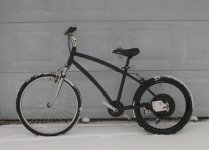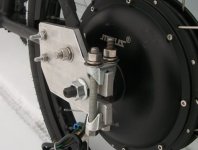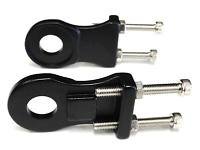spinningmagnets
100 TW
Longer plate and two U-bolts sounds reasonable (maybe 10-inches long, instead of 6?). It was a total brain-fart for me to not realize (until now) it would widen the drop-outs (I blame the beer). I now think this is why the Cromotor and QS have 145/155/165mm drop-out shoulders (depending on source). They clearly could never be run with stock bicycle drop-outs, sooo...If they require torque-plates...why not spec the plates to be mounted on the outside, so the motor can be as wide as possible?
I think the MXUS 3000W has 135mm drop-out shoulders, but...the axle is long enough that any torque arm can be put on the outside of the frames stock drop-outs, and you still have full lugnut engagement.
There is no allowance in the design yet for a disc brake or a derailleur (I didn't want to put a lot of time and effort designing a plate that has disc and derailleur, only to find the material and thickness I chose was not strong enough), I'm just testing 9mm-3/8-inch 6061-T6 aluminum and clamp at 2600W. Anyone who wishes, copy away (open source)...and feel free to water-jet them and sell them. I hope someone makes a profit off of these, so they will be available for purchase.
I think the MXUS 3000W has 135mm drop-out shoulders, but...the axle is long enough that any torque arm can be put on the outside of the frames stock drop-outs, and you still have full lugnut engagement.
There is no allowance in the design yet for a disc brake or a derailleur (I didn't want to put a lot of time and effort designing a plate that has disc and derailleur, only to find the material and thickness I chose was not strong enough), I'm just testing 9mm-3/8-inch 6061-T6 aluminum and clamp at 2600W. Anyone who wishes, copy away (open source)...and feel free to water-jet them and sell them. I hope someone makes a profit off of these, so they will be available for purchase.









